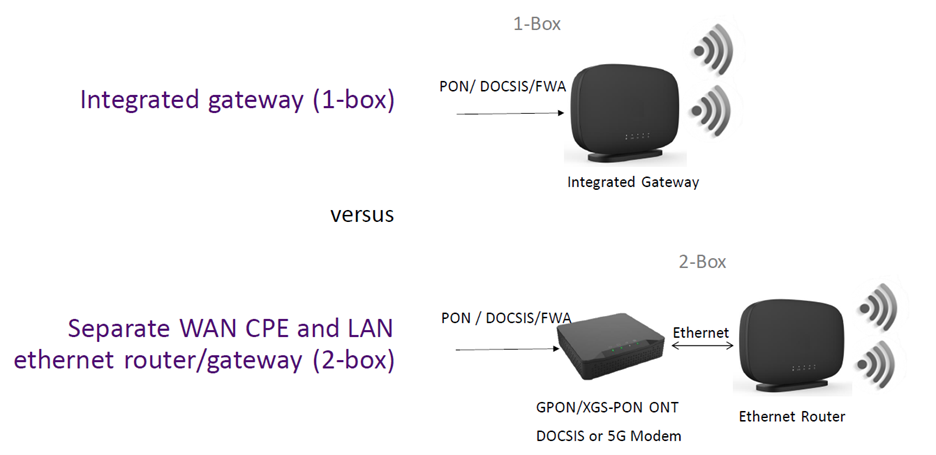What makes up a one-box vs two-box solution?
In simple terms, a two-box solution comprises a DOCSIS cable modem or fiber ONU/ONT, that connects to the ISP, and a separate home gateway/router, which provides the local area network (LAN), e.g. Wi-Fi, Ethernet switch, to connect devices in the home. The two devices are typically connected by an Ethernet cable.
A one-box solution combines the modem/ONU and router into a single device—an integrated gateway.
In some cases, the choice may be simple. For example, government regulations or a network provider’s business model can require a two-box solution.
A one-box solution would, at first sight, be the cheapest option—only one power supply, one case, etc., but when looking at the bigger picture, including lifetime costs, the answer is not as straightforward.

Here is a breakdown of some of the factors to consider when choosing the best solution, based on benefits, challenges, and future outcomes.
Considerations for a one-box vs two-box solution
Demarcation
A two-box solution allows for the physical separation of access (WAN) and home (LAN) networks which is not possible in a one-box solution. The Ethernet port out of the modem/ONU can act as a demarcation point between the access network and the home network, with responsibility for supply, management, and support for the WAN and home network provided by different organizations. For example, a network operator can wholesale network access and allow ISPs to connect their own router with their choice of Wi-Fi, etc. allowing them to differentiate their service offering to consumers.
In some regions, government regulation dictates this model, eliminating one-box as an option.
Costs and investment
Typically, a one-box solution is a lower initial investment for service providers. Manufacturing and deploying a single device is cheaper (e.g. a single PSU, fewer SKUs to manage), and it can be more cost-effective to train technicians, customer service reps, and support people on just one device. However, a two-box solution tends to have lower costs in the long term when technology upgrades are considered. New Wi-Fi standards happen more frequently and at different times to access network upgrades. With a one-box solution, the whole unit needs to be replaced to upgrade the Wi-Fi, while with a two-box solution, only the router is replaced and the modem/ONU can remain unchanged. Conversely, for a network upgrade, the modem/ONU is swapped out and the router stays. This can change the lifetime cost model in favor of two-box and can be more environmentally sustainable.
Installation & deployment
Having a single device to acquire, qualify, deploy, and manage has benefits for the service provider. For the consumer or technician, installation is also simpler. However, two-box solutions can provide more flexibility as to how and when the access network is installed to premises, especially in dense communities with high subscriber turnover, like college campuses, community housing areas, etc. Fiber can be rolled out and the modem/ONU/ONT is installed ahead of customer acquisition, without the additional initial cost of the router. It is also simple to add new subscribers—an in-home gateway can be shipped and self-installed by the consumer, without having to make changes to the WAN side.
Service Management
There are typically no CPU capabilities in the modem/ONU/ONT device, which means limited or no ability for remote monitoring or management of the network performance or the device (e.g. a speed test). These functions have to be done in the router. In a two-box scenario where the router is not provided or managed by the network operator, an option is to add functionality to the modem/ONU/ONT to allow for enhanced monitoring; however, this would incur some additional cost.
CPE Software Upgrades
When it comes to software updates or major upgrades, things can get complicated. For a one-box solution, because everything is aggregated into one device, each time an update is needed the entire device may need to go through a test and validation process. Solution providers may also be forced to rerun access network interoperability activities or have the box qualified and certified on the network again. For a two-box solution, only the device being updated and tested will require additional checks, consuming less time, resources, and budget.
Consumer experience
In some cases, the installation of a one-box solution may not be ideal for the consumer or Wi-Fi performance. An integrated gateway is limited to where in the home the access network cable can reach. For example, if it terminates in the garage or basement, Wi-Fi performance could be compromised, creating the need to add extenders for better coverage—creating more work and additional costs. With a two-box solution, there could be more failure points in the network: additional PSUs, Ethernet cables, and ports to manage and possibly remediate, creating difficulty for the consumer.
Eco benefits
A single device can be a more sustainable option—it will have lower overall power consumption than a two-box solution, with fewer power supplies, less material to make, less packaging, more efficient transport, and less waste. However, as discussed earlier, when upgrades are considered over the long term, the two-box solution can avoid the replacement of hardware, making it a more sustainable option overall.
Which is the best option?
The truth is, there is no one-size-fits-all answer. The right setup can be based on all the factors above and more. Solution providers must follow local regulations, assess their business models, current offerings, consider what their customers want and where their business is going in the future, and then align their findings with current and future demands, goals, and budgets. Cost analysis will depend on a service provider’s particular situation, future plans, and assumptions.
To help our service provider customers, CommScope has created a model to analyze different cost scenarios.
Whichever option is best for you, CommScope Home Networks has one- and two-box solutions for fiber/PON and cable/DOCSIS networks that meet the needs of service providers in today’s and tomorrow’s home markets.
Visit our website to learn more.












